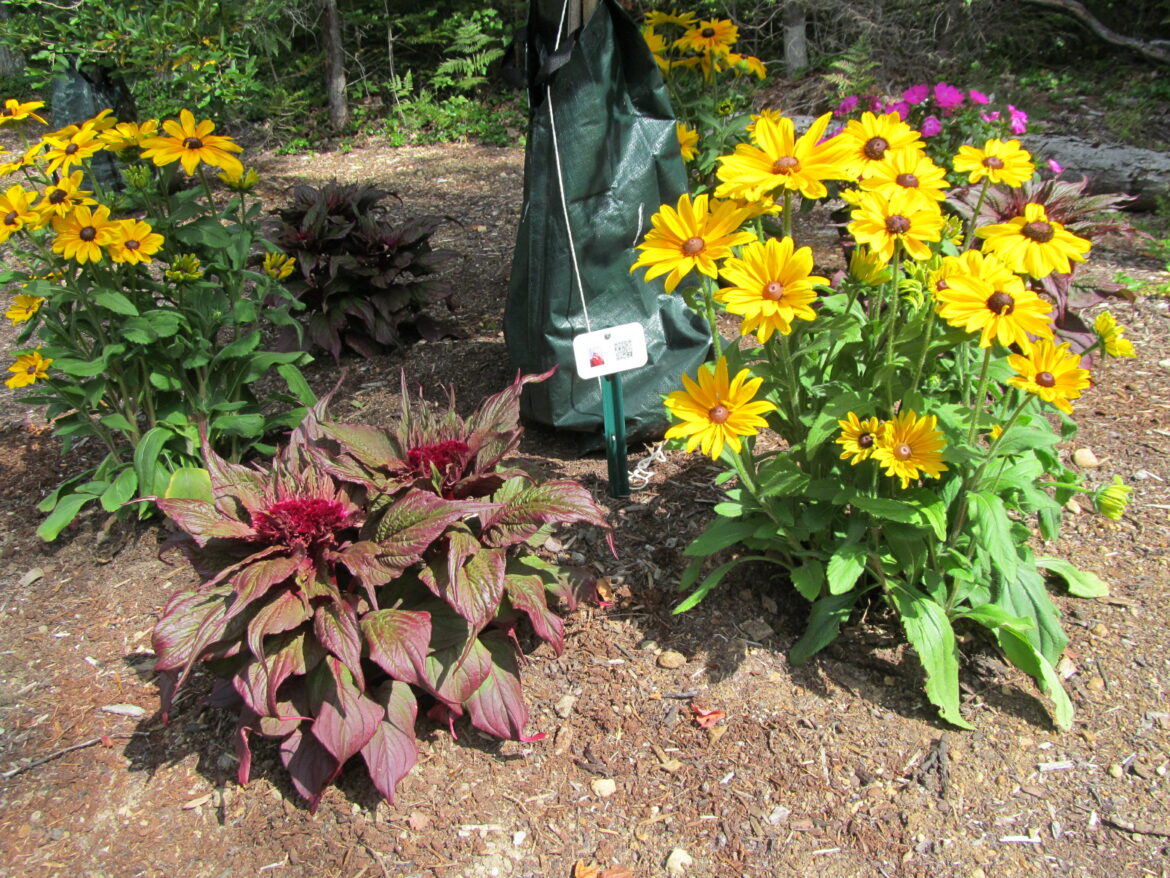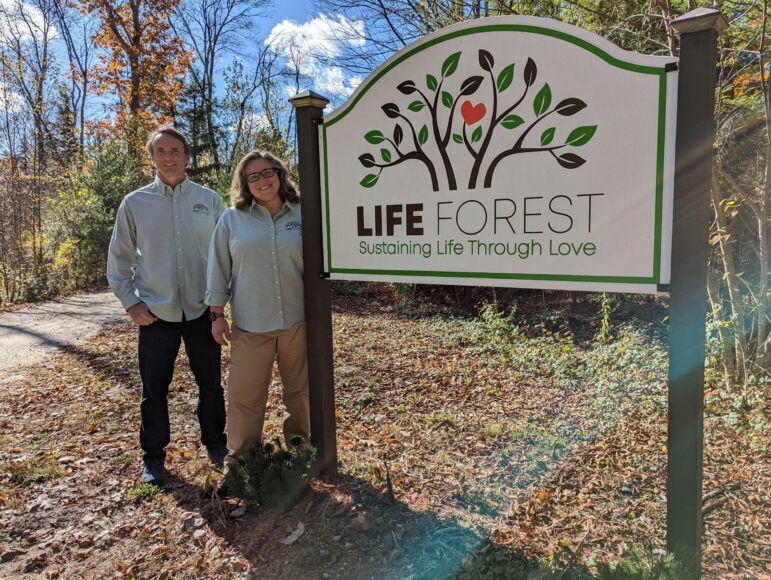
Above, Life Forest founders John O’Neil and Mel Bennett stand at the sign that marks the entrance to Life Forest on Beard Road in Hillsborough. COURTESY PHOTO
By BOB CHAREST, InDepthNH.org
HILLSBOROUGH – Mel Bennett remembers well a day in 2019 when she was trying to get her cemetery ready for its first burials in the woods of Hillsborough, and it didn’t look like things were going to work out.
She wanted a beautiful alternative to a traditional cemetery, where trees and flowering bushes grow in place of headstones, and the grounds are beautiful enough to attract day hikers as well as families to their loved ones’ final resting place. And it had to be wonderful enough that she could bury her own mother there.
Because her idea was a new one for New Hampshire as well as the world, everything she was doing was literally from the ground up. Or below.
The whole concept was thoroughly researched by Bennett, and the result of that inspiration, perspiration and knowledge is the burial of about 110 people and pets in the three and a half years that Life Forest has been operational in a rural area of Hillsborough.
“There was one day and I had my daughters with me, and they were little kids. And I wanted to build a bench, but I didn’t have the money. And so I had two stumps, and the local lumber yard around the corner said I could pick from the scrap pile … I had no power out there. It was hot and it was wicked dry that summer. And I got my little pile of scrap wood. I’m looking at these stumps. One’s higher than the other. I am no Bob Vila, and I have just a hammer and nails. So I’m building all these benches, and it was so hot that day. And I pulled a tick off me, and I’m on this land that looks like Chernobyl.
“I remember I went to nail in this board, and I hammered my thumb and my thumbnail flew off. I lost it. I told myself this is insane. I’d always meet so many people who made fun of me. They’d ask me ‘What are you thinking?’ … I was like a joke.
“And I’m thinking there’s no workers comp and I spent my entire retirement on this. I remember feeling in that one moment, hopeless. Like I have really screwed up. And I said, ‘OK, you’ve got to regroup. You’re a mess. You’re being dramatic.’ And I brought my kids over to the (local Chinese restaurant in Hillsborough). And I got a cold drink and we each got like a lunchbox, whatever they call it. And I opened my fortune cookie. I popped it open, and it said, ‘Your kindness will be your success.’ ”
She jokes now: “So yes, the entire company is built off a fortune cookie.”
But in actuality, the entire company and concept are built off the backs of Mel Bennett and her business partner, John O’Neil. Bennett met O’Neil, of Cambridge, Mass., at an adoption event as both are adoptive parents. O’Neil liked Bennett’s idea when he heard it, and his real estate background and other resources helped Bennett make her dream a reality.
Together, they’ve turned a 13-acre patch of land in Hillsborough into Life Forest, a rather special kind of cemetery that plants trees instead of erecting headstones and allows the cremated remains of family pets to be buried alongside their owners. The forested parcel is surrounded by an 86-acre conservation area owned by the town. Recently, Life Forest became one of the first burial spots in the world to bury composted remains as well as cremated remains (cremains).
There are no bodies buried here, so it doesn’t fit the description of a green burial cemetery. What is here is a peaceful place for families to explore, along with different types and sizes of trees, planted in plots that are marked with, in many instances, the photograph of the deceased and a QR code that links to a site where families can post photos and remembrances.
Life Forest is meant to be explored, and Bennett encourages visitors to come and walk the property. A hiking path through the heavily wooded lot leads down to a brook.
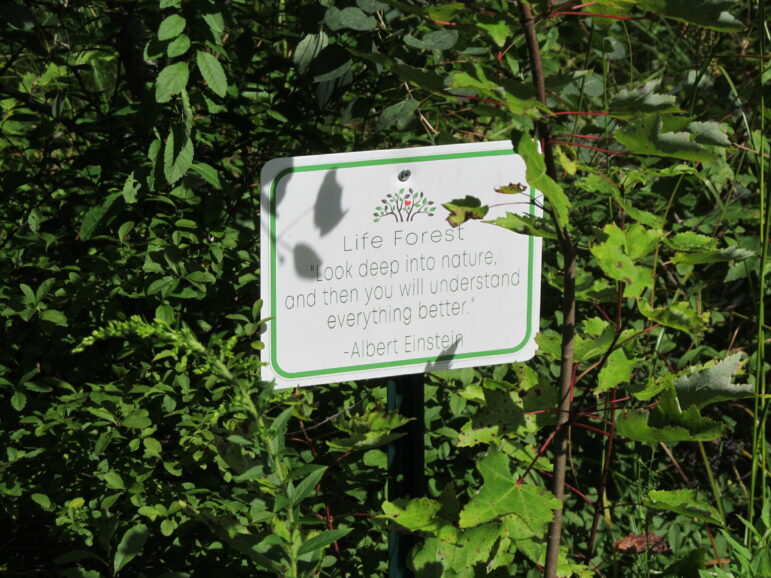
Above, Small signs with inspirational quotes dot the 13-acre preserved area, this one with a quote attributed to Albert Einstein. BOB CHAREST photo
REMEMBERING MOM
Bennett credits her mother with keeping her inspired. Her mother was Life Forest’s first burial. She was diagnosed with early onset dementia when she was in her 50s and died seven years ago at age 64. Elise Dubuque was from Lawrence, Mass., she died in 2016, and her body was cremated. She had lived for a time with Bennett and her daughters before entering a nursing home when her needs became severe. She had been a children’s librarian in Newton, N.H., and when she lived in a Lawrence nursing home, Bennett with her daughters in tow would push her mother up the street from the nursing home to the city library in a specially made contraption resembling a bed on wheels.
“I remember walking her all the way to the library with two small children, and the girls learned to help … they learned to hold doors open for me. My daughter would put lotion on my mom’s hands and brush her hair for her, help feed her, and I would get her to the library just to bring her around the scent of books, and I would read to her. I read her this book about a gentleman who had created a tightrope across two buildings in New York City, and he wanted to walk this tightrope across to these buildings.
“And all of these people were saying, ‘You can’t do that. You can’t do that,’ and he decided to do it anyway. And as he’s standing high in the air on this tightrope, and on the other end of the tightrope were all the police ready to arrest him. He knew that things were not well when he kind of got to the end of this rope, but in that moment, he was truly free. And my mother had not spoken words for so many years and she looked at me and she said, ‘That’s good.’ ”
Nobody actually told Bennett that she couldn’t do what she was planning, only that it would take a lot of work. She didn’t face what could be called resistance, just that people would look at her and send her along on her way to solve yet another issue.
Getting to this point involved a lot more than that hot summer day in 2019 when Bennett gave up a fingernail. There were the applications and the permits and the work of preparing the land, not to mention all the research of deed recording at the county Registry of Deeds and meeting state standards for what can go into the land as well as how to accomplish GPS recording, and then there’s the whole matter of tending to a 13-acre parcel of various-sized trees and other vegetation.
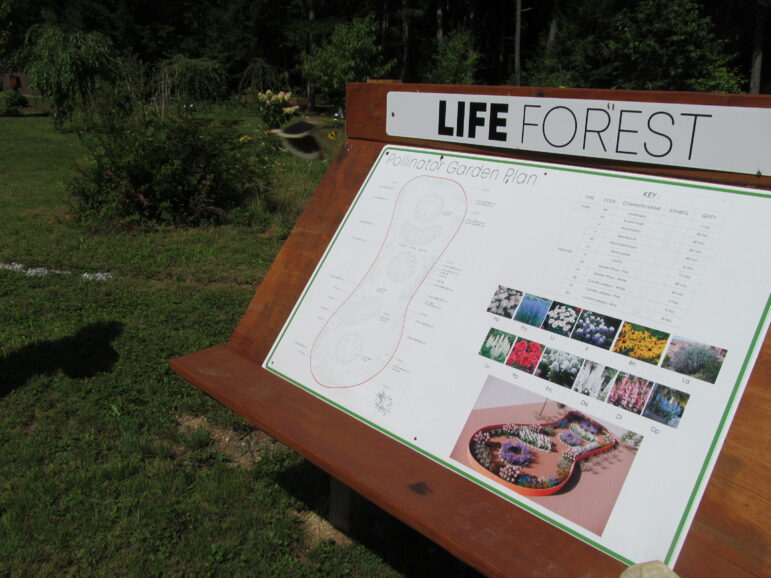
Above, a large sign near the entrance shows the site of the pollinator garden, including the names of the shrubs and perennials that are planted there. Burial sites and a Little Free Library for children are located in this area. A trail leads off toward a brook on abutting conservation land. BOB CHAREST photo
HELP ALONG THE WAY
Bennett, who lives in Manchester, was asked why Life Forest is located in Hillsborough. “The interesting thing about Hillsborough and what attracted us to that area was we were looking specifically for conserved land and strong conservation commissions. Hillsborough, believe it or not, has over 6,000 acres of conservation land. For a small town, that’s pretty impressive,” she said.
There have been lots of people to help out along the way.
She went through the state Department of Environmental Services for a lot of the advance work and plans, and she credits linking up with an ombudsperson for helping her get through all the divisions from which she needed approvals. It was a steep learning process.
“They made you think about every aspect of what you’re doing and what about it works well, what about it doesn’t? How could you do it better?” Bennett said. She worked mainly with the subsurface division, and the person there helped her ask the right questions. When she was asked what she was going to put in the ground, she said ashes. But then she was told, as she relates the conversation: “Well, I don’t have too many concerns about the ashes. However, I’m a little bit concerned about the fact that you want to plant a tree because the ashes could cause acidity in the soil, which wouldn’t be conducive to the growth of the tree.”
So there needed to be a solution to that problem. The one she and others came up with is a woolen burial shroud that protects the cremated remains and the tree’s roots. As the wool biodegrades, it releases sulfur, nitrogen and magnesium that offset the elements produced by the process of cremation.
Bennett credits Sara Johnson, the ombudsperson with the Small Business Technical Assistance Program at the state Department of Environmental Services, with being immensely helpful. “Not only did she guide me through the basics of what each department did, but she also helped me gather answers to random questions that the general public asked me; for example, ‘Can I be buried in a mushroom suit?’…. Ummmmm …. We don’t do that at Life Forest, but Sara, do you know?”
“I’m really kind of a little bit of a catch-all for small businesses as they start with me and I try to figure out where they need to go,” Johnson said.
She remembers Bennett as “very enthusiastic and proactive. She just felt that she was going to figure out a way to make this happen. Or like okay, let’s figure this out how we’re going to make this happen.”
Johnson describes her job as a “problem solver.”
“I never know who’s going to call and what question they’re going to ask,” she said. “I have to know a little bit about everything, but I’m not an expert on anything. I just have to know where to go.
“It’s all about the person who has the idea, and how bad and how much energy they have to get it through. So I definitely recall speaking with her once in length, when we were just brainstorming various programs, and then it was on her watch to call all those programs.”
Bennett contacted people with expertise. They included O’Neil, who has worked in real estate for 25 years, bringing knowledge about laws governing land use. They enlisted help from others to create Life Forest, including a tree surgeon and end-of-life experts.
There was Colton Sawyer, who teaches mathematics at Southern New Hampshire University and is Life Forest’s director of mapping technology. He created a system that uses GPS data to locate burial sites within Life Forest, so that visitors will be able to find loved ones in the future. It’s also a vital part of the legalities that give families a registered record of the burial.
Dr. Caitlyn Hauke, who has a Ph.D. in microbiology and immunology from Dartmouth College, is Life Forest’s director of strategic planning and development, and Dr. Rick Van de Poll is the principal of Ecosystem Management Consultants (EMC) of Sandwich, and is a certified wetland scientist.
Several others help guide families through the process, while others create the wool shrouds, design the website, and tend to the 13 acres.
Also, there was the major concern of how to ensure this will remain hallowed ground for generations to come. The land is protected through conservation easements, and as people’s cremains are buried at the site, their names are added to the deed at the Hillsborough County Registry of Deeds. The latitude and longitude coordinates developed by Sawyer are also recorded.
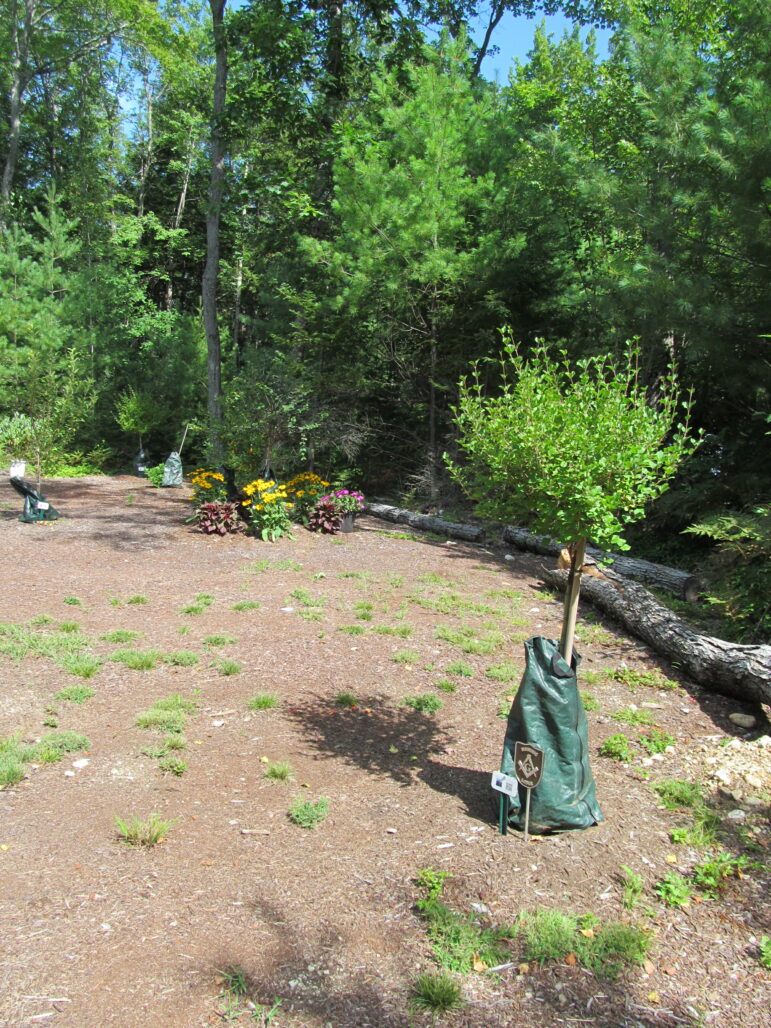
Above, some burial sites are marked with new trees. The green bags around the base are used to hold water that slowly releases to water the roots. BOB CHAREST photo
HOW IT WORKS
In addition to the various types of trees, the pollinator garden and the forested backdrop, the area is dotted with signs of inspirational sayings such as this one: “Trees are the best monuments that a man can erect to his own memory. They speak his praises without flattery, and they are blessings to children yet unborn.” Lord Orrery.
The size of a burial plot chosen is directly related to the size of the tree planted as a memory tree. The length of the roots and the branches need to be respected in relation to other trees, and each tree needs the appropriate amount of space to grow and thrive. The trees are chosen by the families, with many having a special significance to the person buried. A walk through the area reveals many maples, weeping cherries, rose of Sharon, hydrangeas, and other trees and flowers of varying sizes.
Families of those buried here are given a certificate of interment rights listing the GPS coordinates of the gravesite, and the burial is legally recorded at the Hillsborough County Registry of Deeds. Bennett said the deeded access for the burial plots pass to future generations.
The burial sites contain small tags, some with photos of those buried, and a QR code that links to a memorial site with photos, text, and videos of the person, to a charity’s site or to a URL of the family’s choosing.
For those who buy a private burial plot, there is no limit on the number of cremains – either people or pets – that may be buried there. The 7-by-7-foot plots vary in cost depending on the location: arboretum, ornamental garden or memorial preserve, from $4,000 to $5,000. Additional fees and other options are listed on the website, including a single burial of cremains in the pollinator garden at $650 for immediate need burials only.
According to the website, Life Forest’s options solve the problem of what to do with a family member’s remains after they’ve been sitting on a mantle or in a closet for years.
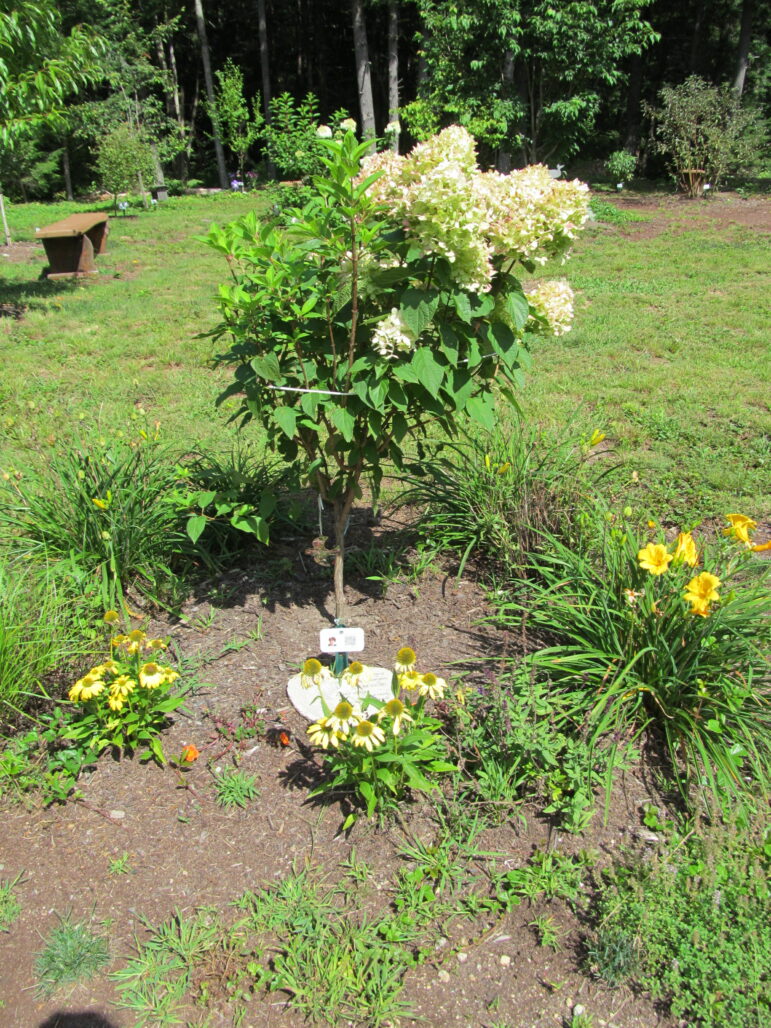
Above, a hydrangea and other flowering bushes mark this grave. The types of flowering bushes and trees are chosen by the family, usually having some significance to the deceased. BOB CHAREST photo
OTHER FEATURES
There’s also a Little Free Library filled with educational stories and workbooks geared to children who have experienced the death of a loved one. The box is located not far from the pollinator garden and is part of the Little Free Library system, a nonprofit organization that has registered more than 125,000 book-sharing boxes in all 50 states, 112 countries, and seven continents.
Another stop along the trail to the brook is the “phone of the wind,” modeled after a phone booth set up in Japan after the 2011 tsunami that killed thousands. An old-fashioned, unconnected rotary telephone is attached to a large tree, where visitors may “call” their loved ones to deliver a message. This symbolic means of communication allows people to express their feelings and emotions in a peaceful setting, with the wind carrying their words and emotions.
The website notes: “We believe a positive surrounding is the foundation of healing and sustaining emotional connection to those who have passed. We have created a space that promotes health, healing, and happiness. We do this by harnessing the energy of plants and reconnecting to our forests.”
Life Forest never charges to bury a child. They will provide a legally documented, single burial plot to anyone who has lost a child up to young adulthood.
Life Forest is not a “green burial” cemetery in the strictest sense of the definition. Most of the 110 or so people and pets interred here are in the form of cremated remains. Composted remains are done off site, and Bennett is now working with a facility in Seattle called Recompose and another in Auburn, Maine. The website calls the composting concept “an environmentally friendly, more affordable, and inclusive alternative to traditional burial.”
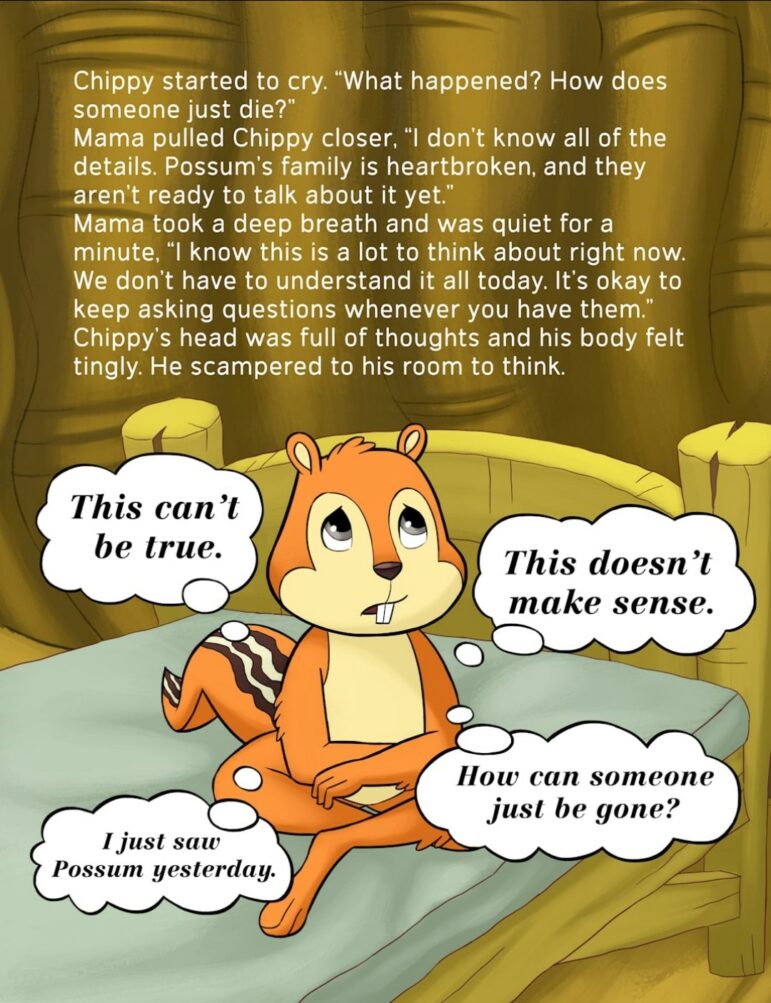
Above, Three authors with experience providing therapy to children are finishing a children’s book, “You Can Always Talk to Possum at Life Forest,” which will be available soon on Amazon. Shown is a page from the book. BOB CHAREST photo
UPCOMING PROJECTS
Bennett has several projects in the works, including a children’s book that will be coming out soon. Called “You Can Always Talk To Possum at Life Forest,” the illustrated book is meant to help children process a loss. Bennett has worked with people who have backgrounds in mental health counseling, and workbook pages at the end are meant to address death and grieving from a child’s mindset. The book, written by Amanda Gooddell, Stephanie Rush and Rachel Lally, features a lovable chipmunk named Chippy who experiences an unexpected loss. The story and an accompanying workbook follow a child’s journey through the stages of grief, coping strategies, and a means to open a conversation. Bennett hopes to make it available to schools, death-care professionals, and as a free download. It will be self-published and available online, including Amazon.
“It’s all written and edited. We’re in the illustration process. I’m hoping that is done within the next few months,” Bennett said.
Life Forest has hosted musicians, concerts, and walks through the woods. Coming up on Oct. 6 is the second annual Midnight Market. Just after dark, from 8 p.m. to midnight, the Life Forest trail will be lined with lanterns, and craftsmen will be selling handmade oddities and curiosities.
“We light up the forest with solar lights, we put them in bags, and we light up the trail. It’s an alternative art market and people can come and purchase local art and they do it at night,” Bennett said. “We’re trying to raise some awareness around that, for awareness around addiction disease and death by suicide.”
Bennett also noted a snowshoe walk is in the planning stages for New Year’s Eve. “We do it every year. A lot of the families come and we’ll go to specific trees and light a candle and talk about the person.”
CONTACT
Life Forest is located at 200 Beard Road, Hillsborough. Contact them through the website at Thelifeforest.com or by phone at 603-315-0790. Email may be sent to inquiries@thelifeforest.com. To visit, Beard Road is located off Route 9 (Franklin Pierce Highway) in Hillsborough.
